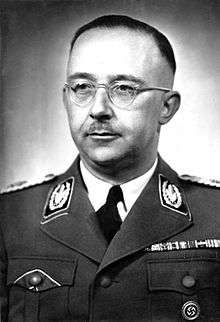Hegewald (colony)

Hegewald was a short-lived German colony during World War II, situated near Zhytomyr in Reichskommissariat Ukraine. It was repopulated in late 1942 and early 1943 by the ethnically German settlers classified as Volksdeutsche; transferred from occupied territories of Poland, Croatia, Bessarabia, and the Soviet Union to an area earmarked for the projected Germanization of the Ukrainian lands. The plans were prepared months in advance by the SS, RKFDV and VoMi, but major problems with supplies have occurred right from the beginning.[1] Heinrich Himmler's original plans to recruit settlers from Scandinavia and the Netherlands were unsuccessful.[2]
History
The initial plans were difficult to implement for a number of reasons including the reluctance and fear among many Volksdeutsche owing to partisan activities in the area. Elaborate guidelines were set up to prepare the locations.[3] The new settlers were to receive the homes of killed or evicted Ukrainian peasants, as well as their furniture, livestock, and food, and schools were to be built.[3] This required a massive deportation effort, mostly on foot.[4] Most homes were in terrible shape by German standards. There was a considerable shortage of lumber, and general lack of winter clothing and shoes.[5]
The Ukrainian and Polish Germans did arrive on trains, having been forcibly removed from their homes, to be doled out plots of land and informed of their quotas.[6] They received use, but not ownership, of the land assigned to them.[7]
Neither the deported Ukrainians nor the ethnic Germans received more than a few hours' notice of their relocation.[7] Despite damage to the houses, most could be made functional before snowfall.[8] Elaborate Christmas pageants were set up, deliberately irreligious, to celebrate the return of light and link it to the "dark powers" surrounding Germany, and gifts and food were provided.[9]
All did not go as planned. The intended preparations were undermined by flinching of craftsmen, and neither food nor clothing arrived as promised.[10] Furthermore, many evicted Ukrainians returned to the area.[11] Efforts were made to continue, with the League of German Girls members being sent even when they had to receive gas masks and soldier escorts, but by November 1943, the inhabitants were in flight before the Red Army.[11] These were the first of massive flights from Eastern Europe.[12]
Villages
The colony consisted of 27 villages, all named in German differently from their traditional names; they were situated along the Zhytomyr-Berdychiv road. The existing villages of today are in the Ukrainian language.[13]
See also
Notes
- ↑ Lynn H. Nicholas, Cruel World: The Children of Europe in the Nazi Web pp. 336, 473, ISBN 0-679-77663-X.
- ↑ Lynn H. Nicholas, Cruel World: The Children of Europe in the Nazi Web p 330-1, ISBN 0-679-77663-X
- 1 2 Nicholas, pp. 331, 474.
- ↑ Nicholas, p 331-2
- ↑ Nicholas, p. 474.
- ↑ Heather Pringle, Heinrich Himmler: The Nazi Leader's Master Plan
- 1 2 Karel C. Berkhoff, Harvest of Despair: Life and Death in Ukraine Under Nazi Rule p 45 ISBN 0-674-01313-1
- ↑ Nicholas, p 336
- ↑ Nicholas, p 336-7,
- ↑ Nicholas, p 338
- 1 2 Nicholas, p 339
- ↑ Nicholas, p 434
- ↑ Lower, Wendy: Nazi empire-building and the Holocaust in Ukraine, p. 176. University of North Carolina Press, 2005.
References
- Lynn H. Nicholas (2011). Cruel World: The Children of Europe in the Nazi Web. Knopf Doubleday Publishing Group. ISBN 0307793826 – via Google Books.
